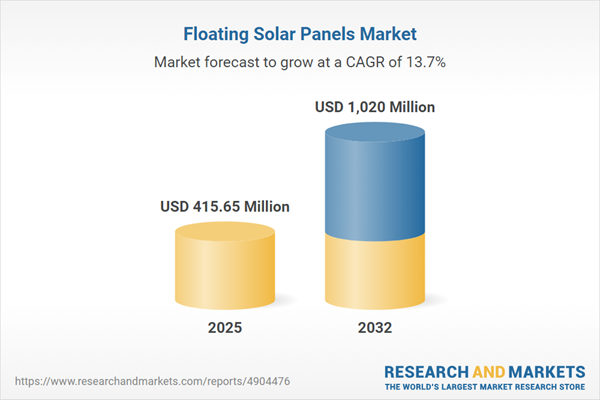Speak directly to the analyst to clarify any post sales queries you may have.
The floating solar panels market is gaining strong momentum as a resilient, space-efficient renewable energy solution for both emerging and developed regions. This report provides actionable insights into trends, opportunities, and strategic considerations, supporting senior executives and stakeholders in capital allocation and long-term planning.
Market Snapshot: Floating Solar Panels Market Overview
The Floating Solar Panels Market grew from USD 365.36 million in 2024 to USD 415.65 million in 2025 and is expected to continue expanding at a CAGR of 13.72%, reaching USD 1.02 billion by 2032. Rising environmental concerns and land use limitations are driving demand for innovative floating photovoltaic technologies. These systems are increasingly deployed in reservoirs, hydropower basins, and quarries, offering dual benefits of renewable generation and water resource management.
Scope & Segmentation of the Floating Solar Panels Market
This report analyzes the evolving landscape across segments and geographies to provide a comprehensive view for industry leaders.
- Cell Types:
- Monocrystalline
- Polycrystalline
- Thin Film
- Module Features:
- Bifacial
- Monofacial
- Capacity Ranges:
- 1 To 5 MW
- Greater Than 5 MW
- Less Than 1 MW
- End Users:
- Commercial
- Industrial
- Residential
- Utility
- Applications:
- Aquaculture
- Irrigation
- Power Generation
- Regions:
- Americas: North America (United States, Canada, Mexico), Latin America (Brazil, Argentina, Chile, Colombia, Peru)
- Europe, Middle East & Africa: Europe (United Kingdom, Germany, France, Russia, Italy, Spain, Netherlands, Sweden, Poland, Switzerland), Middle East (United Arab Emirates, Saudi Arabia, Qatar, Turkey, Israel), Africa (South Africa, Nigeria, Egypt, Kenya)
- Asia-Pacific: China, India, Japan, Australia, South Korea, Indonesia, Thailand, Malaysia, Singapore, Taiwan
- Companies Covered:
- Sungrow Power Supply Co., Ltd.
- Ciel & Terre International S.A.S.
- Kyocera Corporation
- Sharp Corporation
- Trina Solar Co., Ltd.
- Canadian Solar Inc.
- JinkoSolar Holding Co., Ltd.
- First Solar, Inc.
- FIMER S.p.A.
- KACO New Energy GmbH
Key Takeaways: Strategic Insights for Floating Solar Panels Market
- Floating solar panel adoption is redefining renewable infrastructure deployment by enabling power generation without additional land use, enhancing both energy output and ecosystem sustainability.
- Technological progress in materials and digital monitoring drives improved durability, rapid deployment, and predictive maintenance, supporting long-term operational efficiency for large-scale and distributed projects.
- Collaborative frameworks between energy developers and water managers are expanding site suitability while supporting water conservation goals, making these installations attractive for diverse applications including aquaculture and irrigation.
- Segment adoption varies: high-efficiency monocrystalline panels support yield-focused projects, while polycrystalline and thin film technologies address cost-sensitive or challenging environments.
- Regional policy incentives and evolving capital models are accelerating mainstream adoption, with strong momentum in Asia-Pacific, new pilot projects in Europe and the Gulf, and municipal partnerships across the Americas.
Tariff Impact: Navigating Regulatory Shifts in Floating Solar Projects
Recent tariffs introduced in the United States in 2025 have prompted floating solar panel supply chains to adjust procurement strategies and sourcing geography. Market participants are renegotiating contracts, shifting toward domestic manufacturing, and reconfiguring logistics to maintain competitive continuity. This adjustment has encouraged investment in local capabilities and fostered greater supply chain resilience, positioning stakeholders to respond effectively to policy fluctuation and regional risks.
Methodology & Data Sources
Research findings draw on interviews with executives, policymakers, and project developers, as well as field visits to operational sites. Analysis incorporates technical literature, regulatory documents, and proprietary databases, offering a balanced mix of primary and secondary sources to ensure accuracy and relevance.
Why This Report Matters
- Equip your organization with robust insights on market drivers, barriers, and leading technology trends to guide investment and partnership decisions.
- Understand regulatory developments and supply chain adjustments critical for managing tariff risks and optimizing global sourcing strategy in floating solar projects.
- Leverage segmentation analysis and regional perspectives to align offerings with emerging opportunities and sustainability goals.
Conclusion
This analysis highlights the evolution, challenges, and future direction of the floating solar panels market. Stakeholders can benefit from actionable intelligence to strengthen market position, ensure long-term project viability, and support broader environmental and operational objectives.
Additional Product Information:
- Purchase of this report includes 1 year online access with quarterly updates.
- This report can be updated on request. Please contact our Customer Experience team using the Ask a Question widget on our website.
Table of Contents
3. Executive Summary
4. Market Overview
7. Cumulative Impact of Artificial Intelligence 2025
List of Figures
Companies Mentioned
The companies profiled in this Floating Solar Panels market report include:- Sungrow Power Supply Co., Ltd.
- Ciel & Terre International S.A.S.
- Kyocera Corporation
- Sharp Corporation
- Trina Solar Co., Ltd.
- Canadian Solar Inc.
- JinkoSolar Holding Co., Ltd.
- First Solar, Inc.
- FIMER S.p.A.
- KACO New Energy GmbH
Table Information
| Report Attribute | Details |
|---|---|
| No. of Pages | 185 |
| Published | October 2025 |
| Forecast Period | 2025 - 2032 |
| Estimated Market Value ( USD | $ 415.65 Million |
| Forecasted Market Value ( USD | $ 1020 Million |
| Compound Annual Growth Rate | 13.7% |
| Regions Covered | Global |
| No. of Companies Mentioned | 11 |









